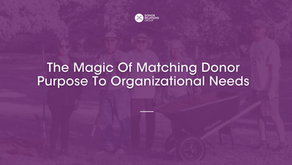Centralizing Acknowledgments: Why The Hybrid Approach Wins Every Time
- Lynne Wester

- Oct 15
- 4 min read
Updated: Oct 28

To centralize or not to centralize—that is the wrong question. The real question is: how do we ensure that every donor feels consistently valued, regardless of where or how they give?
For many organizations, acknowledgments live in a messy, decentralized system. Each unit, department, or program handles things differently, which often leads to inconsistent timing, varied messaging, and worst of all, confused donors. On the flip side, fully centralizing acknowledgments risks stripping away the personal, impact-driven touch that donors crave.
This is why the most effective solution isn’t either/or. It’s both. The sweet spot is a hybrid acknowledgment model—one that combines the efficiency and consistency of central offices with the personal, impact-focused voice of the units.
When done well, a hybrid plan does more than send thank-yous. It reinforces donor trust, builds stronger relationships, and drives retention across the board.

The Best of Both Worlds
Here’s the truth: donors don’t care about your organizational structure. They care about being thanked quickly, personally, and meaningfully.
A hybrid model makes this possible because:
Speed matters. Central offices typically have the necessary technology (CRM automation, ThankView, email tools) to ensure donors receive a timely acknowledgment within a few days.
Impact matters. Units have the relationships and stories that show donors how their gift made a difference.
Consistency matters. When both are coordinated, donors experience your organization as a unified whole, not a collection of disconnected silos.
Put simply, a hybrid model allows central offices to set the standard while units add the heart.
Implementing a Hybrid Approach
Phase 1: Fact Gathering
1. Audit Your Acknowledgments
Start with a full acknowledgment audit. Document what’s happening across units, including processes, timelines, staffing, resources, and any identified gaps. Highlight strong practices and identify pain points. (If you need a roadmap, check out my colleague, Colton Withers’ post, 7 Steps for Success: How to Audit Your Acknowledgments.)
2. Get to Know Your Data
Look at the numbers. How many gifts do you receive annually? What percentage are first-time, recurring, or major donors? How many are made online versus by mail? What are your current open and click-through rates for digital acknowledgments? These insights help you prioritize and customize your hybrid approach.
3. Assess Your Tech Stack What tools already exist that can be utilized to streamline the process of acknowledgments? Audit CRMs, marketing platforms, storytelling tools, and project management systems. Identify what both central and unit teams can access and where gaps exist before mapping your workflows.
Phase 2: Review and Planning
1. Form an Acknowledgment Committee
Partnership is the foundation of a successful hybrid model. Assemble a group of central and unit staff to co-create the process. This ensures buy-in, eliminates silos, and creates advocates who will champion the new plan internally.
2. Develop a Framework With your committee, design the structure:
Who sends what type of acknowledgment?
What timelines should be standard?
How will workflows be tracked?
A tool like the RACI model helps clarify roles and responsibilities.
3. Gain Leadership Approval
Package your framework into a compelling, visual plan. Use a platform like Canva to create a simple chart showing what donors receive, from whom, and when. Frame it not just as an operational improvement but as a donor retention strategy—because it is.
When making your case to leadership, lead with the retention opportunity. Hybrid doesn’t just help donors, it helps the bottom line. Donors who feel acknowledged and informed are far more likely to give again.
Phase 3: Implementation
1. Pilot the ProgramTest your new approach with one unit before rolling it out enterprise-wide. Use the pilot to refine training, identify bottlenecks, and strengthen communication channels.
2. Assess and AdjustMeasure what matters: donor satisfaction, retention, response times, and partner engagement. Build in regular review cycles and incorporate donor feedback loops. Success isn’t “set it and forget it,” it’s continuous improvement.

What Hybrid Looks Like in Action
Here’s an example of several hybrid acknowledgment touches and how they could play out in practice:
Immediate (Central): The donor receives an immediate, personalized thank-you email triggered through the CRM. It includes gift details and a message of gratitude. This is not the gift receipt.
Days 7-10: (Central + Unit): The donor receives a standard, but personalized unit-branded ThankView or postcard message, developed in partnership with the unit and executed by the central team.
Month 1 (Unit): The donor receives a handwritten card or video message from the unit where their gift will have an impact.
Month 3 (Central +Unit): A coordinated follow-up, such as a newsletter story or impact report, showing how gifts are making a difference.
This layered approach strikes a balance between timeliness and authenticity, ensuring donors feel valued while also understanding the long-term impact of their generosity.
If you’ve ever debated centralizing acknowledgments, you know there’s no one-size-fits-all answer. Fully centralizing may be the most efficient approach in your organization, but it can also risk losing the personal touch. Fully decentralizing can feel meaningful, but it often creates inconsistencies in the donor experience and can lead to delays.
That’s why the hybrid model works. It allows central teams to do what they do best—set standards, utilize technology, and move quickly—while units focus on what they do best—communicating the direct impact of gifts.
The truth is, donors don’t see your org chart. They only see how you show up for them. A hybrid acknowledgment plan keeps the process timely, personal, and consistent, which is what every donor deserves.
It’s not easy work, but it’s the kind of work that builds donor trust and long-term loyalty. Ultimately, it’s how we transform a simple 'thank you' into a lasting relationship.
Written by Stacey Halphen





